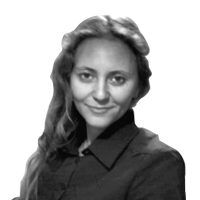KIEV — The bronze statue had been shoved off its marble pedestal facedown on rain-wet asphalt, and a large hole in the sculpted body of the once well-respected Bolshevik revealed its hollow insides.
A few pedestrians stopped on the way to the Beresteiskaya metro station, wondering who the historical figure could be: Demyan Korotchenko, the former head of commissars’ council in the Ukrainian Socialist Republic. He is long since forgotten, unwanted and unappreciated by busy Ukrainians busy with their efforts to cleanse the country of old Communist symbols. His statue was one of three Soviet-era monuments destroyed in Kiev on Wednesday alone. At least one Lenin statue was demolished in eastern Ukraine the same day.
After 25 years of independence, Ukraine seems determined at last to divorce itself from its old communist heritage and and get rid of the baggage from those days. Busts and statues of Soviet heroes are falling one after another. Thousands of streets, 806 villages and 24 cities, including Dniprodzerzhynsk, Kirovograd, and Dnipropetrovsk, are going to be renamed. Souvenir sellers have hidden away all their T-shirts and other products decorated with what had seemed nostalgic or campy red stars and hammers and sickles.
Both Soviet and Nazi symbols are now forbidden in Ukraine by law. But it’s the Soviet icons, once dumped on the country in industrial quantities, which now are disappearing in record numbers.
Since December 2013, Ukrainians knocked down 500 out of over 1,200 Lenin statues, a trend known as “Lenin-fall,” which in Ukrainian sounds like snowfall. Recently, Ukrainian President Petro Poroshenko signed a law that formally charged the state with removing Soviet-era monuments, so now Kiev’s municipal services are responsible for destroying statues.
“Look, the bust was gone with the wind today,” said Nataliya Gumenyuk of Hromadske TV, pointing at a bare pedestal that since 1976 had supported the head of one Andrei Ivanov, a Communist Party activist. “I am not even sure who that Ivanov was, to be honest with you.”
The ideologist behind Ukraine’s four new laws on the “de-communization” of its history, Volodymyr Viatrovych, told The Daily Beast he was happy to see real changes at last. And he noted that they go well beyond toppling statues.
“Our biggest news is that KGB, interior ministry and counter intelligence archives were opened to the public last week,” he said. “Finally! It took us almost two decades of constant struggle against the protectors of secrecy. While Russia rehabilitates the Soviet past, in Ukraine today everybody who wants can apply for an appointment and access most secret documents dated from 1917 to 1991.”
Unlike Ukraine and most Eastern European countries, Russia chose not to reveal material from before 1991 and has kept its NKVD and KGB secrets sealed. It is worth noting that Russian President Vladimir Putin and many of his closest advisers are KGB veterans. The Moscow archives were briefly available to the public in the early 1990s, but since the “secret” seals on most Soviet documents have been extended for 30 years. These include a large number of documents dated 1937-38, the peak of Stalin’s Great Purge and the Moscow show trials made famous in the West by the novel Darkness at Noon.
At present, Russia’s state secrets are multiplying by the day. On Thursday, Putin declared that information about Russian soldiers dying during special operations carried out in peacetime is to be classified as a state secret.
So Ukraine’s new transparency dealing with that part of its past is laudable. But other aspects of its new history legislation have been criticized widely in the West.
In April, 40 historians asked President Poroshenko not to sign the law recognizing a number of World War II nationalist organizations, including the Ukrainian Insurgent Army (UPA), as mere independence fighters. In a letter addressed to Ukrainian authorities the critics questioned the legitimacy of an organization “that slaughtered tens of thousands of Poles in one of the most heinous acts of ethnic cleansing in the history of Ukraine.”
Western historians pointed out that Ukraine should not be praising as heroes organizations that collaborated with Nazi Germany. The UPA “also took part in anti-Jewish pogroms in Ukraine and, in the case of the Melnyk faction, remained allied with the [Nazi] occupation regime throughout the war,” their letter said.
The U.S. Holocaust Memorial Museum has expressed concerns about Ukraine’s radical treatment of its history: “As Ukraine advances on the difficult road to full democracy, we strongly urge the nation’s government to refrain from any measure that preempts or censors discussion or politicizes the study of history.”
George Orwell put the fundamental problem rather more elegantly in an essay he wrote toward the end of World War II, when he argued that history is written by the winners. “The really frightening thing about totalitarianism is not that it commits ‘atrocities’ but that it attacks the concept of objective truth; it claims to control the past as well as the future.” And that tradition is one Ukraine is still trying to shake off.
Vyatrovych conceded, for instance, that some UPA activists were involved in Jewish pogroms, “since Jews were blamed for helping Bolsheviks,” but he rejected the idea that the whole of the UPA was at fault. “There were many Ukrainian nationalists who saved Jews, too, during the war,” he told The Daily Beast. “Besides, who could not be blamed for atrocities during that war? Americans bombed Dresden,” said Vyatrovych, whose title is director of the Ukrainian Institute of National Memory.






